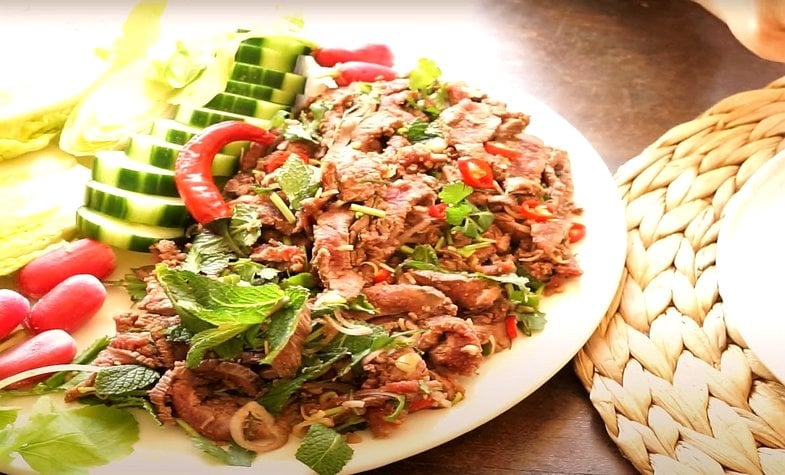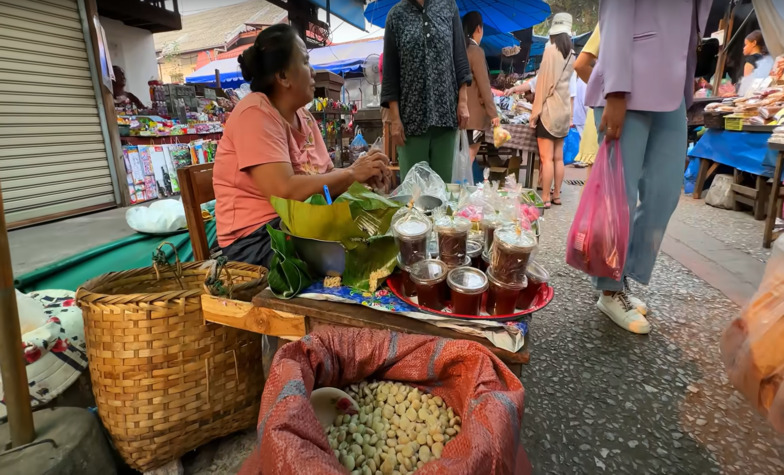Laos cuisine boasts a unique flavor profile that harmoniously blends spicy, sour, and fresh notes from natural ingredients. Each dish is a distinctive cultural experience, reflecting the communal lifestyle and long-standing traditions of the Lao people. Embark on a culinary journey through Laos to discover its unique flavors, experience the culture through its characteristic tastes, and savor the traditional dining style of this nation.
The characteristics of Laos cuisine
Laos cuisine boasts a bold and harmonious flavor profile, derived from natural ingredients and unique spices. One of its most iconic dishes is "laap," a raw minced meat salad mixed with lemongrass, Vietnamese coriander, and fermented rice powder. The meat is seasoned and mixed to achieve a balanced flavor that is both refreshing and subtly spicy. Lao dishes often incorporate fresh herbs like lemongrass, lime leaves, and green chili peppers, along with fish sauce, creating a distinctive and alluring aroma that leaves diners craving more.

Lao people embrace a leisurely dining experience, often gathering around a communal table to share meals and stories. Sticky rice, formed into small balls, is a staple food enjoyed with various dishes. The use of hands for eating is a unique aspect of Lao dining culture, reflecting a rustic and communal way of life. Beyond the food itself, this custom fosters a sense of connection and shared experience among Lao people.
Laos cuisine famous
-
Larb is a truly unique dish, a type of minced meat salad typically made with beef, chicken, or fish, and mixed with fragrant herbs like lemongrass, shallots, chili peppers, and toasted rice powder. Larb offers a fresh, spicy, and harmonious flavor profile that is quintessentially Lao.
-
Tam Mak Houng is a popular green papaya salad with a perfect balance of sour, spicy, and savory flavors. It’s made with fresh papaya, chili peppers, garlic, dried shrimp, and fish sauce.
-
Or Lam is a traditional Lao stew made with meat (chicken, beef, or fish), root vegetables like sweet potato and bamboo shoots, and distinctive spices such as mak khua leaves and fermented fish. It offers a rich, savory flavor with a hint of sweetness and a touch of spice.

-
Khao Niao is a sweet and chewy sticky rice that is a beloved staple in Laos cuisine. It's versatile and can be enjoyed with a variety of dishes, from savory grilled meats to sweet toppings.
-
Khao Niao Ma Muang is a delightful dessert featuring sweet, sticky rice served with ripe mango slices and a drizzle of creamy coconut milk.
-
Mok Pa is a Vietnamese steamed fish wrapped in a banana leaf. The combination of the fish and the banana leaf creates a unique and aromatic flavor.
-
Bo Xao Dua is a simple yet flavorful dish featuring stir-fried beef with pickled vegetables, garlic, onion, and chili peppers. The combination of sweet beef and tangy pickled vegetables creates a unique and delicious taste.
Festivals & Food Experiences
In Luang Prabang, the morning alms giving is more than a ritual – it’s a spiritual food experience. As the sun rises, you’ll join locals in offering warm sticky rice to saffron-robed monks, then savor a simple yet soulful Lao breakfast. If you come during Pi Mai Lao (Lao New Year), food becomes the heart of the celebration. Streets fill with laughter, water splashing, and endless trays of traditional dishes – from Laap to sweet sticky rice desserts. It’s not just eating; it’s tasting the joy of Lao culture at its most festive.

There’s no better way to dive into Lao cuisine than rolling up your sleeves with locals. Imagine pounding herbs in a stone mortar to make Laap, or wrapping marinated fish in banana leaves before steaming it into fragrant Mok Pa. After class, wander into a bustling market – the night bazaar of Luang Prabang or Vientiane’s morning market – where smoky grills, colorful spices, and trays of sticky rice beckon. Miss it, and you’ll miss the most authentic flavors of Laos hidden in plain sight.
Helpful tips for enjoying Laos cusine
Laos cuisine is more than just food; it's an experience. Slow down, savor each dish and share the joy of eating with friends and family. Lao people often eat with their hands, especially with sticky rice, creating a sense of intimacy. Try eating like a local and enjoy the relaxed atmosphere as you savor the rich flavors of this beautiful country.

Laos cuisine is more than just delicious food; it's a vibrant tapestry of the country's culture and people. From spicy to sour flavors and the communal way of sharing meals with family, every dining experience is unique and meaningful. If you ever have the chance to visit Laos, don't miss the opportunity to savor traditional dishes and fully immerse yourself in the Lao culture. Exploring Lao food will give you a deeper understanding of the local lifestyle, affection, and hospitality.
Our tours you may like:
***
Travel Authentic Asia Company is your best choice for discovering the beauty of Southeast Asia. Our experienced and knowledgeable travel advisors are committed to helping you create a tailor-made tour and extraordinary experiences in this majestic region.
If you're looking for an authentic cultural experience, do not hesitate to contact Travel Authentic Asia to choose a Vietnam tour, Southeast Asia tour package or to customize your own style tour to South East Asia.

